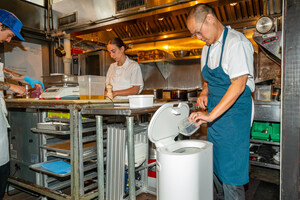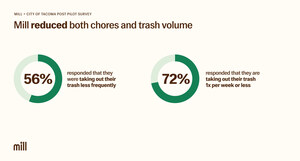Days after the announcement of the Biden-Harris Administration's National Strategy to Reduce Food Loss and Waste and Recycle Organics, Mill's new data demonstrates tangible progress: the food-recycling system has processed over two million pounds of food in its first year of operations and is influencing cooking and shopping behavior to help people save money and reduce waste
SAN BRUNO, Calif., June 18, 2024 /PRNewswire/ -- Award-winning food-recycling system Mill today announced new data from its first year of operations helping American households prevent food waste. Mill's insights represent the largest, most accurate look at food waste behavior in homes ever measured. The data shows that Mill is increasing awareness of food waste, driving consumer behavior changes, and presenting new opportunities for people to save money and reduce waste.
Mill is the food recycling system from Nest Cofounder Matt Rogers and early Nest leader Harry Tannenbaum that turns household food scraps into clean, dry grounds that can feed farms or gardens. Built by engineers from Apple and Google, Mill's food recycler is sensitive to food scrap inputs as small as 15 grams—the equivalent of a single strawberry—which means Mill has a precise understanding of how much food is being added to its fleet of connected food-recyclers. This means that households across the country now have real-time visibility into how much food they're wasting and can act on it.
Mill aggregated millions of device days of data from April 2023 to May 2024, and found that the median Mill household added around 5.5 pounds of food scraps per household per week. Notably, the median amount of food scraps added to Mill decreased over time—by over 20% over the first four months—and then stabilized. Survey results from customers reinforced this pattern, with one in three respondents sharing that using Mill decreased the amount of food waste they generated. Notably, 73% of respondents reported putting zero food into the trash after having Mill at home.1
This demonstrates that Mill is changing behavior in a sustained way. In a time of record inflation and rising food prices, with the average American family wasting almost $1,900 per year on uneaten food2, a 20% reduction in food waste could save households at least $380 per year.
"No one likes wasting food, and changing behavior is hard. That's why, when designing Mill, we focused on making it incredibly easy to use. We also know that it's very difficult to improve things that aren't measured. That's why it was so critical to us to include feedback loops for measurement, so households are able to track their progress and take action to save time and money. Our first year of data—which is the first of its kind ever generated—shows unequivocally that Mill is working," said Harry Tannenbaum, Cofounder and President of Mill. "If we can process over 2 million pounds of household food in a little over a year—and help people become more aware of and reduce the amount of excess food they buy at the store—the long-term impact of Mill will be enormous, from both an environmental and an economic perspective."
Mill's new data comes on the heels of last week's announcement from the U.S. Department of Agriculture (USDA), the U.S. Environmental Protection Agency (EPA), the U.S. Food and Drug Administration (FDA), and the White House of the National Strategy to Reduce Food Loss and Waste and Recycle Organics. The National Strategy emphasizes the importance of improving measurement of food loss and waste and tracking progress toward goals. These include efforts to monitor, measure, and verify the efficacy of programmatic efforts, as well as a $2.5 million investment in consumer message testing and outreach. This announcement underscores the increasing importance of tackling food waste in America, not just as an environmental consideration but also an economic one.
Mill surveyed hundreds of its customers on their food waste behaviors at home before and after using Mill. The majority of respondents shared that Mill had increased their awareness of how much food they were wasting, with 59% saying they produced more food waste than they thought. This insight was driven by a combination of having the food recycler at home and impact reporting in the Mill app.
Implications for Researchers, Governments, Educators, and Consumer Advocates
Mill's data has important implications for researchers, food waste advocates, and waste management leaders seeking precise ways to measure and impact food waste behavior in the kitchen and increase organics diversions efforts. Mill's insights can be leveraged at the community level to help local leaders understand and influence the unique challenges of organics collection, and make more informed procurement decisions.
Until Mill, no tool existed to precisely measure household food waste generation. Instead, cities have had to rely on costly and imprecise waste characterization studies that estimate tons delivered to landfill. Mill's innovative connected measurement system can uncover unique, unprecedented, household-level data about behavior related to food waste in the home.
Professor Brian Roe, Leader of the Ohio State University Food Waste Collaborative, commented:
"The Mill data provides a compelling lens through which to understand food waste behavior among one segment of the U.S. population, and may yield insights that can be leveraged by both private and public entities to help consumers reduce waste and save money."
About Mill Industries Inc. ("Mill")
Mill makes it easy to prevent food waste at home with an innovative new kitchen experience and pathways that keep food out of landfills. Food isn't trash. Together, we can do better.
Mill was founded in 2020 by Matt Rogers and Harry Tannenbaum, who worked together at Nest, building the iconic Nest Learning Thermostat and other smart home products. The lessons they learned about encouraging new habits at home that are good for people and the planet were applied in creating Mill to change our perception of waste, starting in the kitchen.
Mill is a trademark of Mill Industries Inc.
Follow Mill: Instagram and Facebook
1 The respondents who were still tossing some food scraps in the trash said they were mostly from the small list of inputs Mill doesn't accept, such as very large bones or excessively moldy food. Before Mill, only 8% of respondents reported putting zero food scraps in the garbage.
2 This calculation assumes 2.5 persons/household according to 2022 US Census Bureau; Bureau of Labor Statistics and 2022 data from ReFED that the average American spends $759 on food that goes uneaten: https://refed.org/food-waste/consumer-food-waste
SOURCE Mill Industries Inc.

WANT YOUR COMPANY'S NEWS FEATURED ON PRNEWSWIRE.COM?
Newsrooms &
Influencers
Digital Media
Outlets
Journalists
Opted In






Share this article